Crime Research and Analysis Report: Cannabis Decriminalisation Effects
VerifiedAdded on 2021/05/31
|15
|3229
|66
Report
AI Summary
This report presents research on the controversial topic of cannabis decriminalisation and its effects on crime rates. The study explores the prevalence of drug use, highlighting the adverse consequences associated with it, with a specific focus on marijuana. The research employs a mixed-methods approach, including surveys and interviews, to gather both quantitative and qualitative data. The findings reveal insights into the perceptions and experiences of individuals regarding cannabis use, its potential impact on crime, and the implications of legalisation. The report also analyzes the methodology, discussing the advantages and disadvantages of both quantitative and qualitative research methods. The conclusion underscores the complexities of cannabis decriminalisation and the need for careful consideration of its potential effects on public health and safety.
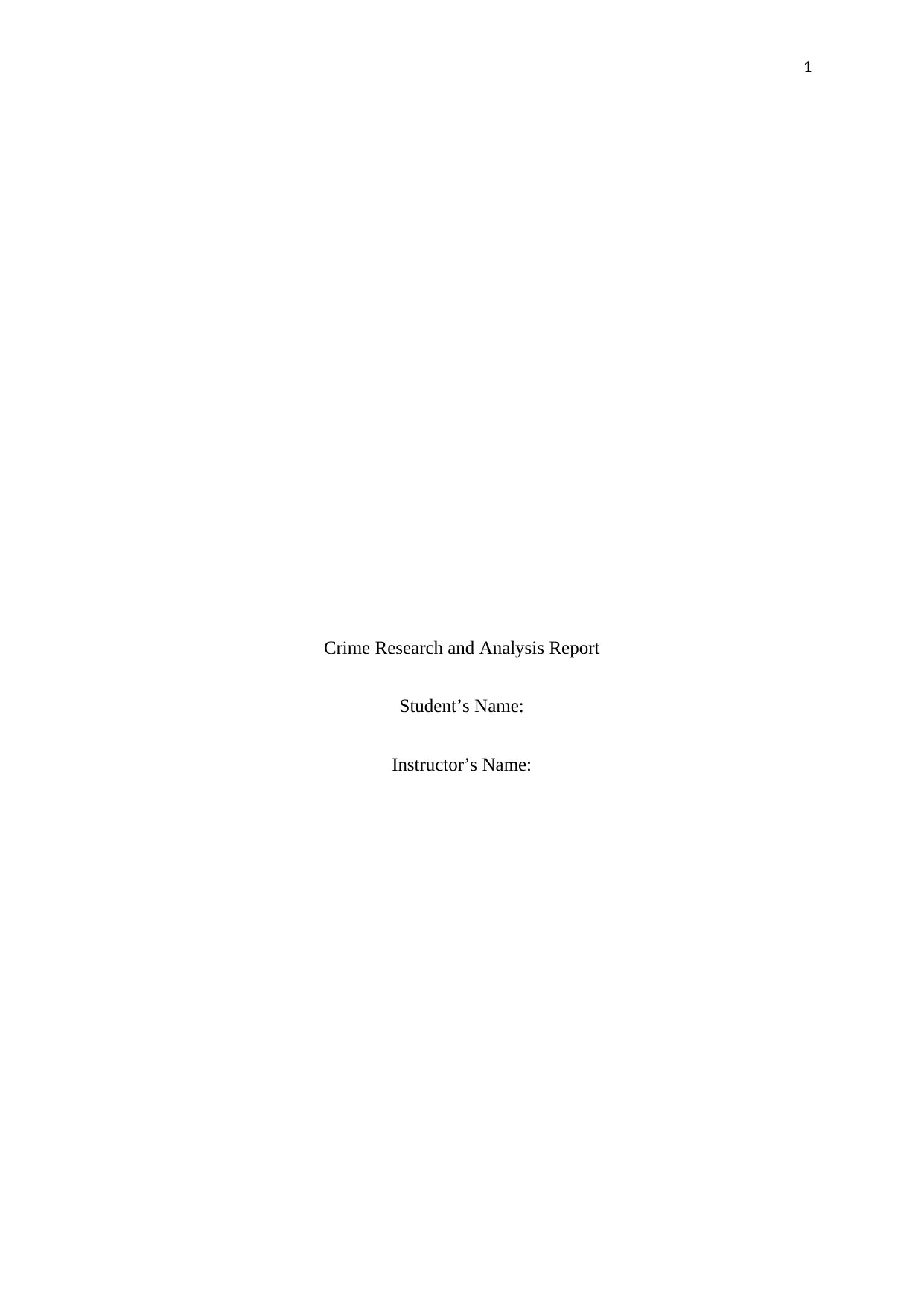
1
Crime Research and Analysis Report
Student’s Name:
Instructor’s Name:
Crime Research and Analysis Report
Student’s Name:
Instructor’s Name:
Paraphrase This Document
Need a fresh take? Get an instant paraphrase of this document with our AI Paraphraser
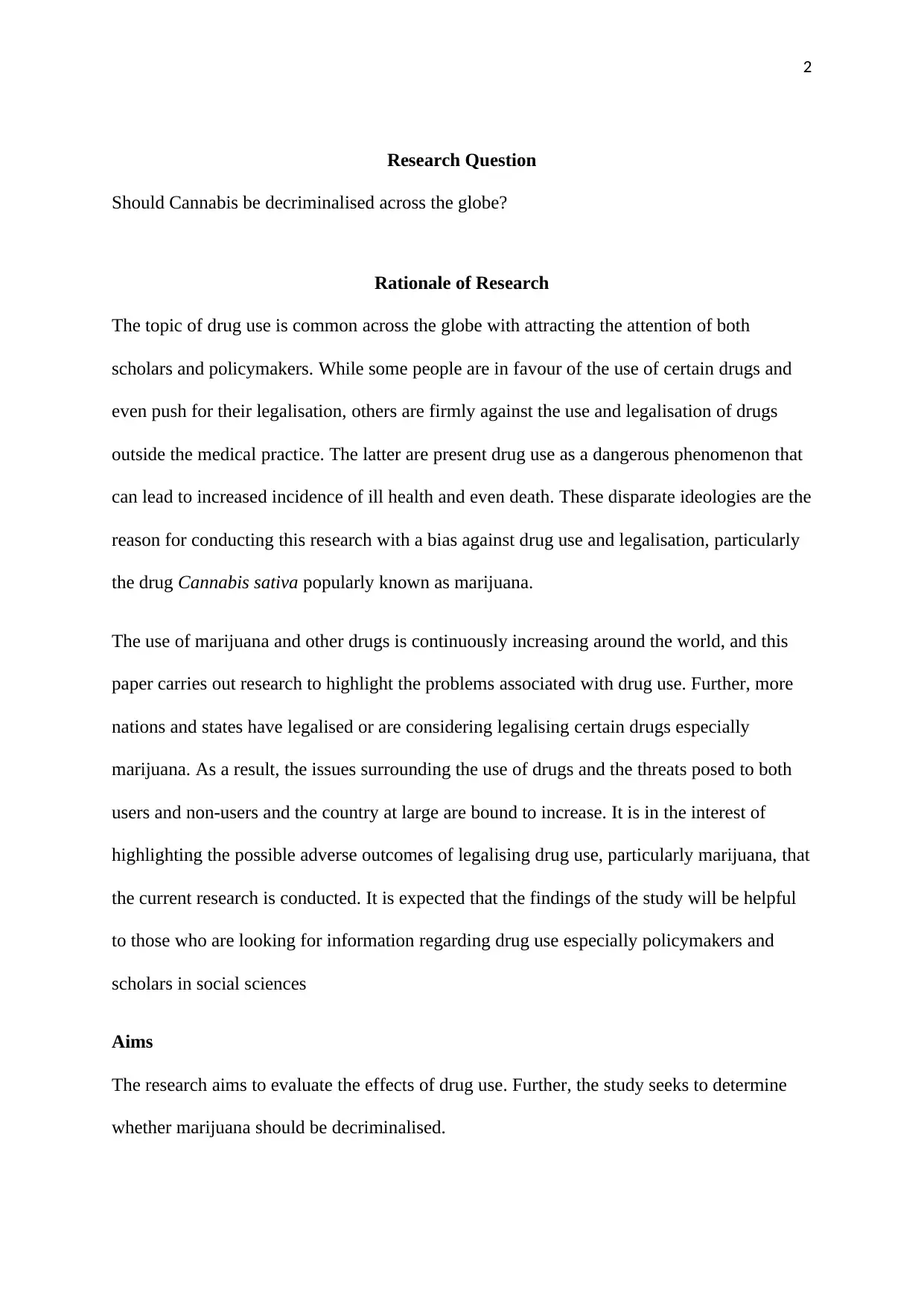
2
Research Question
Should Cannabis be decriminalised across the globe?
Rationale of Research
The topic of drug use is common across the globe with attracting the attention of both
scholars and policymakers. While some people are in favour of the use of certain drugs and
even push for their legalisation, others are firmly against the use and legalisation of drugs
outside the medical practice. The latter are present drug use as a dangerous phenomenon that
can lead to increased incidence of ill health and even death. These disparate ideologies are the
reason for conducting this research with a bias against drug use and legalisation, particularly
the drug Cannabis sativa popularly known as marijuana.
The use of marijuana and other drugs is continuously increasing around the world, and this
paper carries out research to highlight the problems associated with drug use. Further, more
nations and states have legalised or are considering legalising certain drugs especially
marijuana. As a result, the issues surrounding the use of drugs and the threats posed to both
users and non-users and the country at large are bound to increase. It is in the interest of
highlighting the possible adverse outcomes of legalising drug use, particularly marijuana, that
the current research is conducted. It is expected that the findings of the study will be helpful
to those who are looking for information regarding drug use especially policymakers and
scholars in social sciences
Aims
The research aims to evaluate the effects of drug use. Further, the study seeks to determine
whether marijuana should be decriminalised.
Research Question
Should Cannabis be decriminalised across the globe?
Rationale of Research
The topic of drug use is common across the globe with attracting the attention of both
scholars and policymakers. While some people are in favour of the use of certain drugs and
even push for their legalisation, others are firmly against the use and legalisation of drugs
outside the medical practice. The latter are present drug use as a dangerous phenomenon that
can lead to increased incidence of ill health and even death. These disparate ideologies are the
reason for conducting this research with a bias against drug use and legalisation, particularly
the drug Cannabis sativa popularly known as marijuana.
The use of marijuana and other drugs is continuously increasing around the world, and this
paper carries out research to highlight the problems associated with drug use. Further, more
nations and states have legalised or are considering legalising certain drugs especially
marijuana. As a result, the issues surrounding the use of drugs and the threats posed to both
users and non-users and the country at large are bound to increase. It is in the interest of
highlighting the possible adverse outcomes of legalising drug use, particularly marijuana, that
the current research is conducted. It is expected that the findings of the study will be helpful
to those who are looking for information regarding drug use especially policymakers and
scholars in social sciences
Aims
The research aims to evaluate the effects of drug use. Further, the study seeks to determine
whether marijuana should be decriminalised.
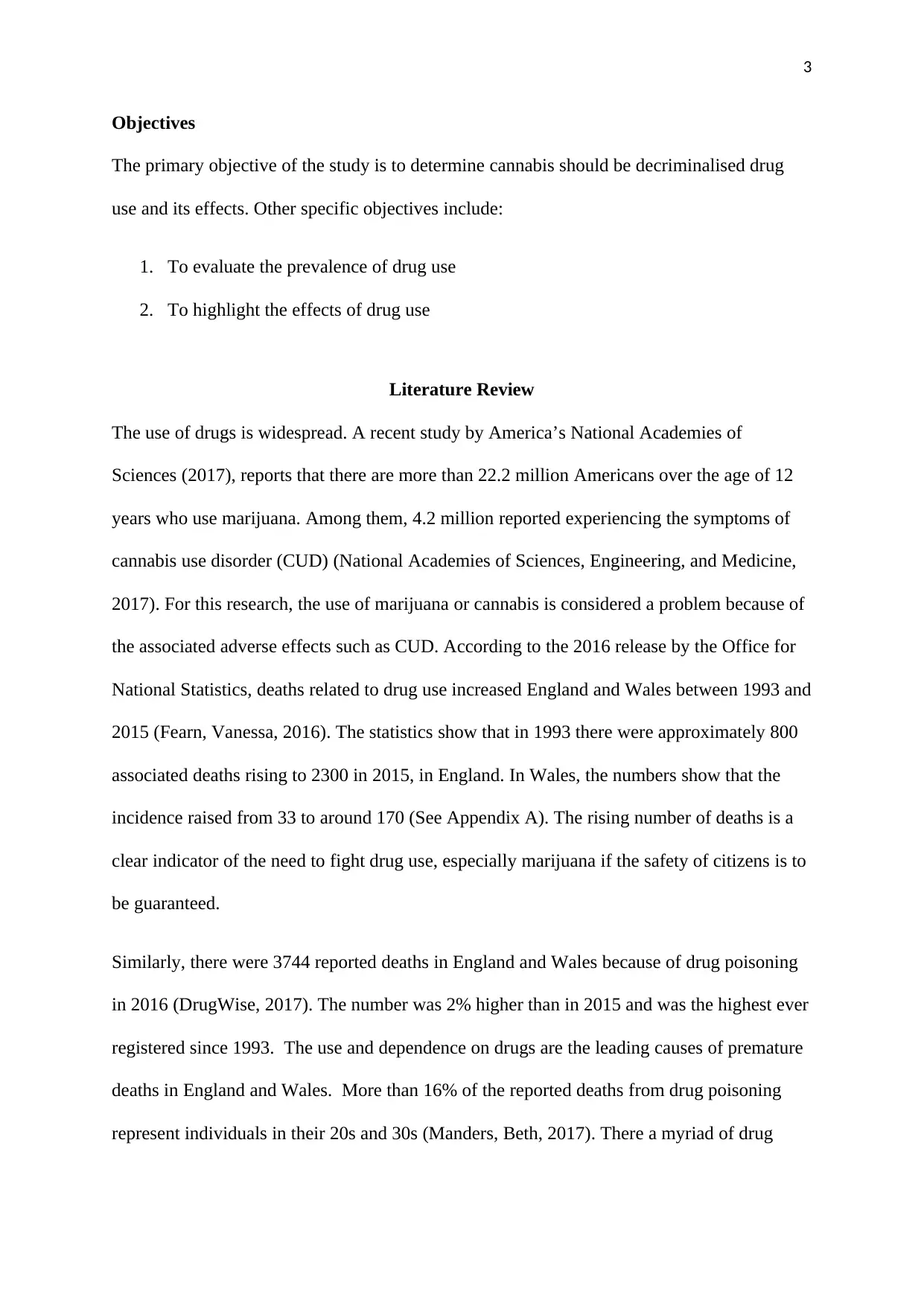
3
Objectives
The primary objective of the study is to determine cannabis should be decriminalised drug
use and its effects. Other specific objectives include:
1. To evaluate the prevalence of drug use
2. To highlight the effects of drug use
Literature Review
The use of drugs is widespread. A recent study by America’s National Academies of
Sciences (2017), reports that there are more than 22.2 million Americans over the age of 12
years who use marijuana. Among them, 4.2 million reported experiencing the symptoms of
cannabis use disorder (CUD) (National Academies of Sciences, Engineering, and Medicine,
2017). For this research, the use of marijuana or cannabis is considered a problem because of
the associated adverse effects such as CUD. According to the 2016 release by the Office for
National Statistics, deaths related to drug use increased England and Wales between 1993 and
2015 (Fearn, Vanessa, 2016). The statistics show that in 1993 there were approximately 800
associated deaths rising to 2300 in 2015, in England. In Wales, the numbers show that the
incidence raised from 33 to around 170 (See Appendix A). The rising number of deaths is a
clear indicator of the need to fight drug use, especially marijuana if the safety of citizens is to
be guaranteed.
Similarly, there were 3744 reported deaths in England and Wales because of drug poisoning
in 2016 (DrugWise, 2017). The number was 2% higher than in 2015 and was the highest ever
registered since 1993. The use and dependence on drugs are the leading causes of premature
deaths in England and Wales. More than 16% of the reported deaths from drug poisoning
represent individuals in their 20s and 30s (Manders, Beth, 2017). There a myriad of drug
Objectives
The primary objective of the study is to determine cannabis should be decriminalised drug
use and its effects. Other specific objectives include:
1. To evaluate the prevalence of drug use
2. To highlight the effects of drug use
Literature Review
The use of drugs is widespread. A recent study by America’s National Academies of
Sciences (2017), reports that there are more than 22.2 million Americans over the age of 12
years who use marijuana. Among them, 4.2 million reported experiencing the symptoms of
cannabis use disorder (CUD) (National Academies of Sciences, Engineering, and Medicine,
2017). For this research, the use of marijuana or cannabis is considered a problem because of
the associated adverse effects such as CUD. According to the 2016 release by the Office for
National Statistics, deaths related to drug use increased England and Wales between 1993 and
2015 (Fearn, Vanessa, 2016). The statistics show that in 1993 there were approximately 800
associated deaths rising to 2300 in 2015, in England. In Wales, the numbers show that the
incidence raised from 33 to around 170 (See Appendix A). The rising number of deaths is a
clear indicator of the need to fight drug use, especially marijuana if the safety of citizens is to
be guaranteed.
Similarly, there were 3744 reported deaths in England and Wales because of drug poisoning
in 2016 (DrugWise, 2017). The number was 2% higher than in 2015 and was the highest ever
registered since 1993. The use and dependence on drugs are the leading causes of premature
deaths in England and Wales. More than 16% of the reported deaths from drug poisoning
represent individuals in their 20s and 30s (Manders, Beth, 2017). There a myriad of drug
⊘ This is a preview!⊘
Do you want full access?
Subscribe today to unlock all pages.

Trusted by 1+ million students worldwide
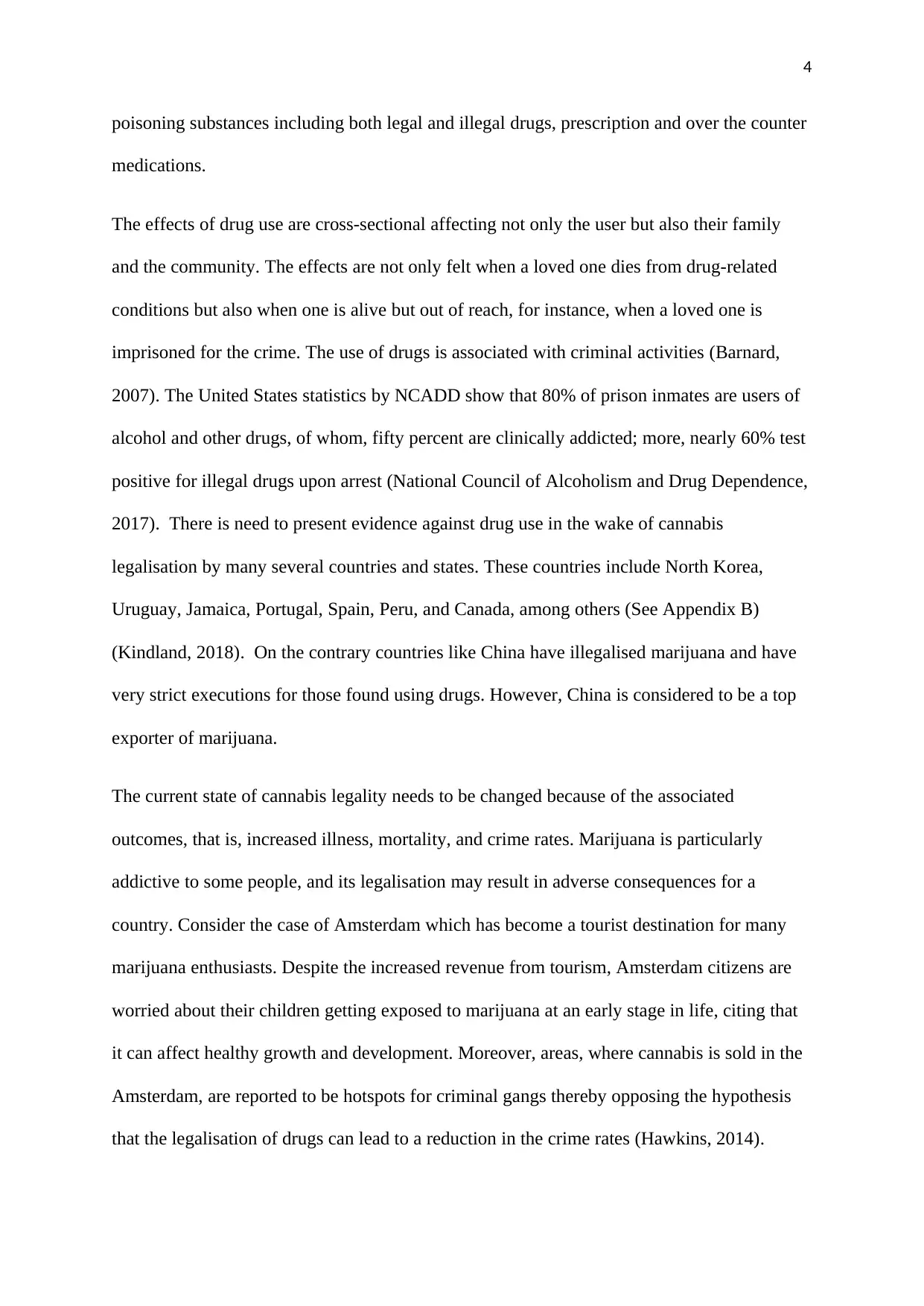
4
poisoning substances including both legal and illegal drugs, prescription and over the counter
medications.
The effects of drug use are cross-sectional affecting not only the user but also their family
and the community. The effects are not only felt when a loved one dies from drug-related
conditions but also when one is alive but out of reach, for instance, when a loved one is
imprisoned for the crime. The use of drugs is associated with criminal activities (Barnard,
2007). The United States statistics by NCADD show that 80% of prison inmates are users of
alcohol and other drugs, of whom, fifty percent are clinically addicted; more, nearly 60% test
positive for illegal drugs upon arrest (National Council of Alcoholism and Drug Dependence,
2017). There is need to present evidence against drug use in the wake of cannabis
legalisation by many several countries and states. These countries include North Korea,
Uruguay, Jamaica, Portugal, Spain, Peru, and Canada, among others (See Appendix B)
(Kindland, 2018). On the contrary countries like China have illegalised marijuana and have
very strict executions for those found using drugs. However, China is considered to be a top
exporter of marijuana.
The current state of cannabis legality needs to be changed because of the associated
outcomes, that is, increased illness, mortality, and crime rates. Marijuana is particularly
addictive to some people, and its legalisation may result in adverse consequences for a
country. Consider the case of Amsterdam which has become a tourist destination for many
marijuana enthusiasts. Despite the increased revenue from tourism, Amsterdam citizens are
worried about their children getting exposed to marijuana at an early stage in life, citing that
it can affect healthy growth and development. Moreover, areas, where cannabis is sold in the
Amsterdam, are reported to be hotspots for criminal gangs thereby opposing the hypothesis
that the legalisation of drugs can lead to a reduction in the crime rates (Hawkins, 2014).
poisoning substances including both legal and illegal drugs, prescription and over the counter
medications.
The effects of drug use are cross-sectional affecting not only the user but also their family
and the community. The effects are not only felt when a loved one dies from drug-related
conditions but also when one is alive but out of reach, for instance, when a loved one is
imprisoned for the crime. The use of drugs is associated with criminal activities (Barnard,
2007). The United States statistics by NCADD show that 80% of prison inmates are users of
alcohol and other drugs, of whom, fifty percent are clinically addicted; more, nearly 60% test
positive for illegal drugs upon arrest (National Council of Alcoholism and Drug Dependence,
2017). There is need to present evidence against drug use in the wake of cannabis
legalisation by many several countries and states. These countries include North Korea,
Uruguay, Jamaica, Portugal, Spain, Peru, and Canada, among others (See Appendix B)
(Kindland, 2018). On the contrary countries like China have illegalised marijuana and have
very strict executions for those found using drugs. However, China is considered to be a top
exporter of marijuana.
The current state of cannabis legality needs to be changed because of the associated
outcomes, that is, increased illness, mortality, and crime rates. Marijuana is particularly
addictive to some people, and its legalisation may result in adverse consequences for a
country. Consider the case of Amsterdam which has become a tourist destination for many
marijuana enthusiasts. Despite the increased revenue from tourism, Amsterdam citizens are
worried about their children getting exposed to marijuana at an early stage in life, citing that
it can affect healthy growth and development. Moreover, areas, where cannabis is sold in the
Amsterdam, are reported to be hotspots for criminal gangs thereby opposing the hypothesis
that the legalisation of drugs can lead to a reduction in the crime rates (Hawkins, 2014).
Paraphrase This Document
Need a fresh take? Get an instant paraphrase of this document with our AI Paraphraser
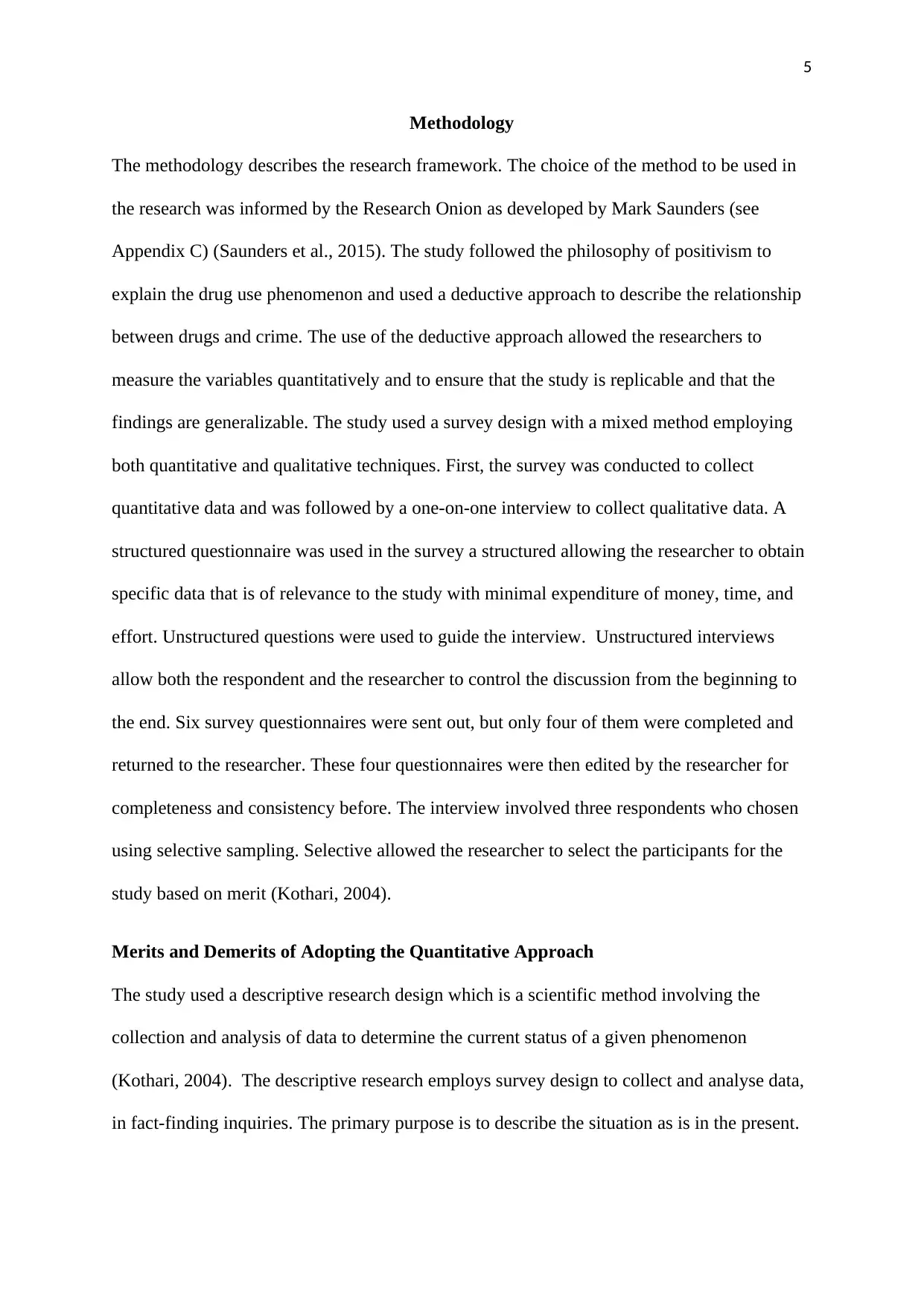
5
Methodology
The methodology describes the research framework. The choice of the method to be used in
the research was informed by the Research Onion as developed by Mark Saunders (see
Appendix C) (Saunders et al., 2015). The study followed the philosophy of positivism to
explain the drug use phenomenon and used a deductive approach to describe the relationship
between drugs and crime. The use of the deductive approach allowed the researchers to
measure the variables quantitatively and to ensure that the study is replicable and that the
findings are generalizable. The study used a survey design with a mixed method employing
both quantitative and qualitative techniques. First, the survey was conducted to collect
quantitative data and was followed by a one-on-one interview to collect qualitative data. A
structured questionnaire was used in the survey a structured allowing the researcher to obtain
specific data that is of relevance to the study with minimal expenditure of money, time, and
effort. Unstructured questions were used to guide the interview. Unstructured interviews
allow both the respondent and the researcher to control the discussion from the beginning to
the end. Six survey questionnaires were sent out, but only four of them were completed and
returned to the researcher. These four questionnaires were then edited by the researcher for
completeness and consistency before. The interview involved three respondents who chosen
using selective sampling. Selective allowed the researcher to select the participants for the
study based on merit (Kothari, 2004).
Merits and Demerits of Adopting the Quantitative Approach
The study used a descriptive research design which is a scientific method involving the
collection and analysis of data to determine the current status of a given phenomenon
(Kothari, 2004). The descriptive research employs survey design to collect and analyse data,
in fact-finding inquiries. The primary purpose is to describe the situation as is in the present.
Methodology
The methodology describes the research framework. The choice of the method to be used in
the research was informed by the Research Onion as developed by Mark Saunders (see
Appendix C) (Saunders et al., 2015). The study followed the philosophy of positivism to
explain the drug use phenomenon and used a deductive approach to describe the relationship
between drugs and crime. The use of the deductive approach allowed the researchers to
measure the variables quantitatively and to ensure that the study is replicable and that the
findings are generalizable. The study used a survey design with a mixed method employing
both quantitative and qualitative techniques. First, the survey was conducted to collect
quantitative data and was followed by a one-on-one interview to collect qualitative data. A
structured questionnaire was used in the survey a structured allowing the researcher to obtain
specific data that is of relevance to the study with minimal expenditure of money, time, and
effort. Unstructured questions were used to guide the interview. Unstructured interviews
allow both the respondent and the researcher to control the discussion from the beginning to
the end. Six survey questionnaires were sent out, but only four of them were completed and
returned to the researcher. These four questionnaires were then edited by the researcher for
completeness and consistency before. The interview involved three respondents who chosen
using selective sampling. Selective allowed the researcher to select the participants for the
study based on merit (Kothari, 2004).
Merits and Demerits of Adopting the Quantitative Approach
The study used a descriptive research design which is a scientific method involving the
collection and analysis of data to determine the current status of a given phenomenon
(Kothari, 2004). The descriptive research employs survey design to collect and analyse data,
in fact-finding inquiries. The primary purpose is to describe the situation as is in the present.
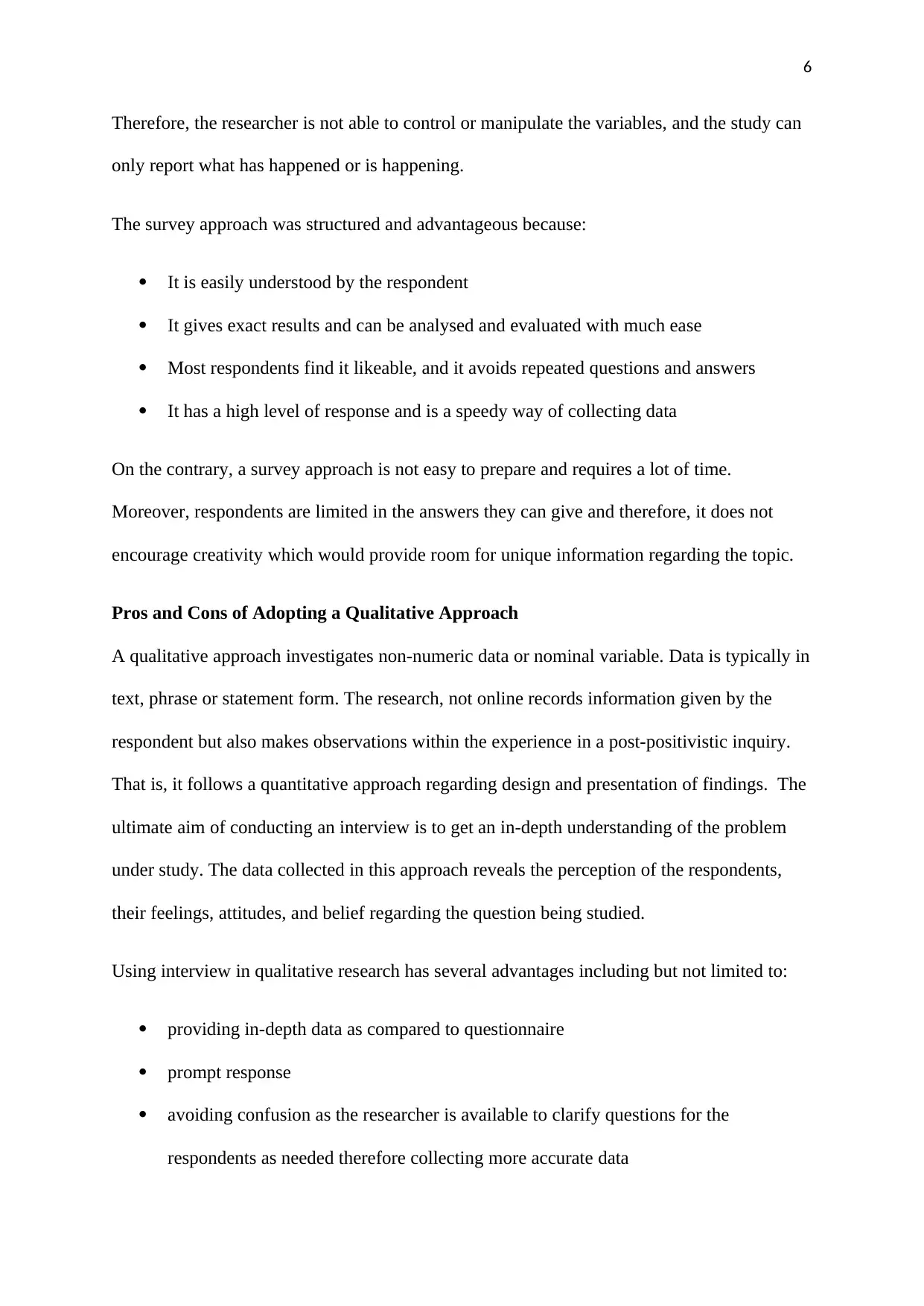
6
Therefore, the researcher is not able to control or manipulate the variables, and the study can
only report what has happened or is happening.
The survey approach was structured and advantageous because:
It is easily understood by the respondent
It gives exact results and can be analysed and evaluated with much ease
Most respondents find it likeable, and it avoids repeated questions and answers
It has a high level of response and is a speedy way of collecting data
On the contrary, a survey approach is not easy to prepare and requires a lot of time.
Moreover, respondents are limited in the answers they can give and therefore, it does not
encourage creativity which would provide room for unique information regarding the topic.
Pros and Cons of Adopting a Qualitative Approach
A qualitative approach investigates non-numeric data or nominal variable. Data is typically in
text, phrase or statement form. The research, not online records information given by the
respondent but also makes observations within the experience in a post-positivistic inquiry.
That is, it follows a quantitative approach regarding design and presentation of findings. The
ultimate aim of conducting an interview is to get an in-depth understanding of the problem
under study. The data collected in this approach reveals the perception of the respondents,
their feelings, attitudes, and belief regarding the question being studied.
Using interview in qualitative research has several advantages including but not limited to:
providing in-depth data as compared to questionnaire
prompt response
avoiding confusion as the researcher is available to clarify questions for the
respondents as needed therefore collecting more accurate data
Therefore, the researcher is not able to control or manipulate the variables, and the study can
only report what has happened or is happening.
The survey approach was structured and advantageous because:
It is easily understood by the respondent
It gives exact results and can be analysed and evaluated with much ease
Most respondents find it likeable, and it avoids repeated questions and answers
It has a high level of response and is a speedy way of collecting data
On the contrary, a survey approach is not easy to prepare and requires a lot of time.
Moreover, respondents are limited in the answers they can give and therefore, it does not
encourage creativity which would provide room for unique information regarding the topic.
Pros and Cons of Adopting a Qualitative Approach
A qualitative approach investigates non-numeric data or nominal variable. Data is typically in
text, phrase or statement form. The research, not online records information given by the
respondent but also makes observations within the experience in a post-positivistic inquiry.
That is, it follows a quantitative approach regarding design and presentation of findings. The
ultimate aim of conducting an interview is to get an in-depth understanding of the problem
under study. The data collected in this approach reveals the perception of the respondents,
their feelings, attitudes, and belief regarding the question being studied.
Using interview in qualitative research has several advantages including but not limited to:
providing in-depth data as compared to questionnaire
prompt response
avoiding confusion as the researcher is available to clarify questions for the
respondents as needed therefore collecting more accurate data
⊘ This is a preview!⊘
Do you want full access?
Subscribe today to unlock all pages.

Trusted by 1+ million students worldwide
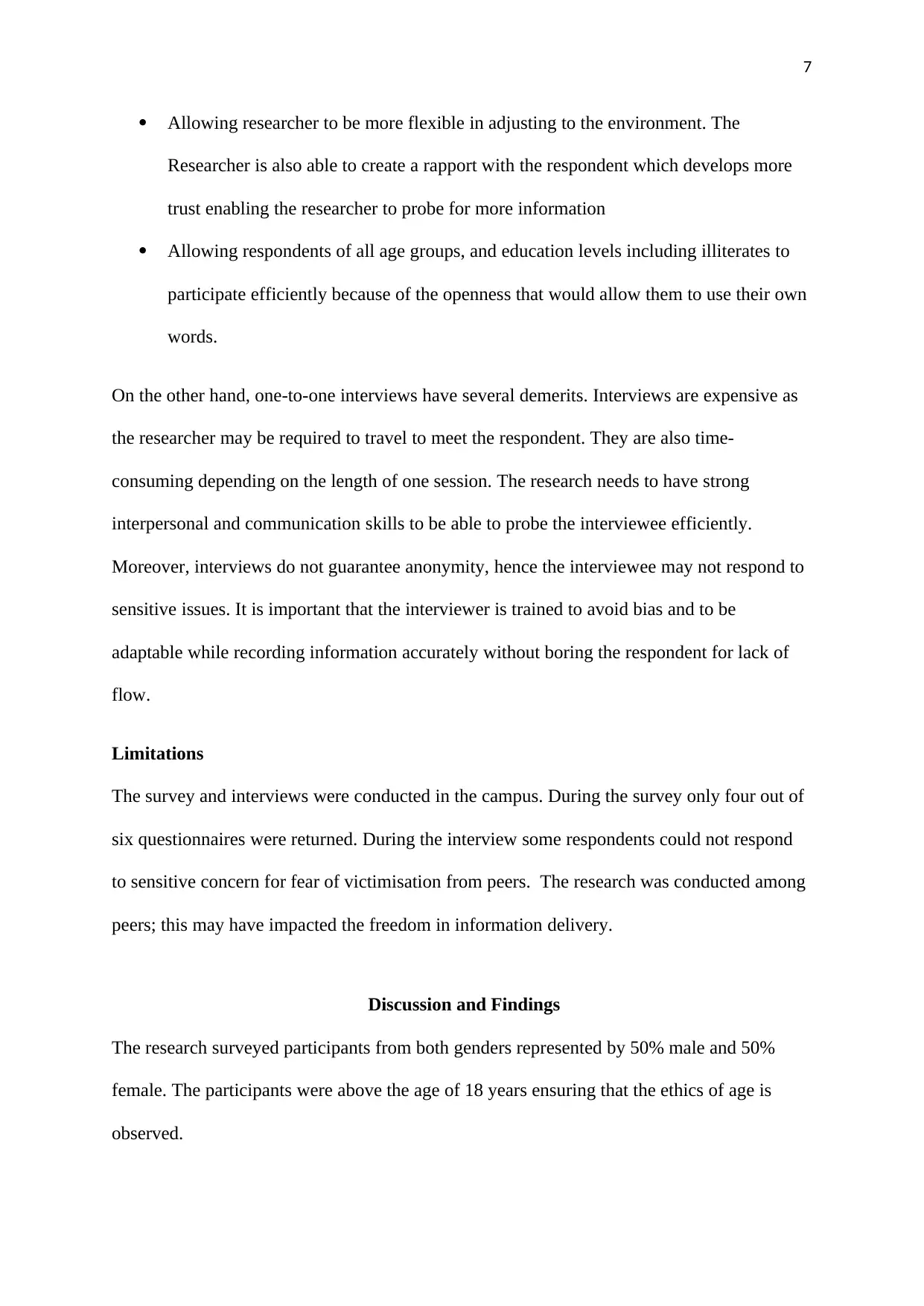
7
Allowing researcher to be more flexible in adjusting to the environment. The
Researcher is also able to create a rapport with the respondent which develops more
trust enabling the researcher to probe for more information
Allowing respondents of all age groups, and education levels including illiterates to
participate efficiently because of the openness that would allow them to use their own
words.
On the other hand, one-to-one interviews have several demerits. Interviews are expensive as
the researcher may be required to travel to meet the respondent. They are also time-
consuming depending on the length of one session. The research needs to have strong
interpersonal and communication skills to be able to probe the interviewee efficiently.
Moreover, interviews do not guarantee anonymity, hence the interviewee may not respond to
sensitive issues. It is important that the interviewer is trained to avoid bias and to be
adaptable while recording information accurately without boring the respondent for lack of
flow.
Limitations
The survey and interviews were conducted in the campus. During the survey only four out of
six questionnaires were returned. During the interview some respondents could not respond
to sensitive concern for fear of victimisation from peers. The research was conducted among
peers; this may have impacted the freedom in information delivery.
Discussion and Findings
The research surveyed participants from both genders represented by 50% male and 50%
female. The participants were above the age of 18 years ensuring that the ethics of age is
observed.
Allowing researcher to be more flexible in adjusting to the environment. The
Researcher is also able to create a rapport with the respondent which develops more
trust enabling the researcher to probe for more information
Allowing respondents of all age groups, and education levels including illiterates to
participate efficiently because of the openness that would allow them to use their own
words.
On the other hand, one-to-one interviews have several demerits. Interviews are expensive as
the researcher may be required to travel to meet the respondent. They are also time-
consuming depending on the length of one session. The research needs to have strong
interpersonal and communication skills to be able to probe the interviewee efficiently.
Moreover, interviews do not guarantee anonymity, hence the interviewee may not respond to
sensitive issues. It is important that the interviewer is trained to avoid bias and to be
adaptable while recording information accurately without boring the respondent for lack of
flow.
Limitations
The survey and interviews were conducted in the campus. During the survey only four out of
six questionnaires were returned. During the interview some respondents could not respond
to sensitive concern for fear of victimisation from peers. The research was conducted among
peers; this may have impacted the freedom in information delivery.
Discussion and Findings
The research surveyed participants from both genders represented by 50% male and 50%
female. The participants were above the age of 18 years ensuring that the ethics of age is
observed.
Paraphrase This Document
Need a fresh take? Get an instant paraphrase of this document with our AI Paraphraser
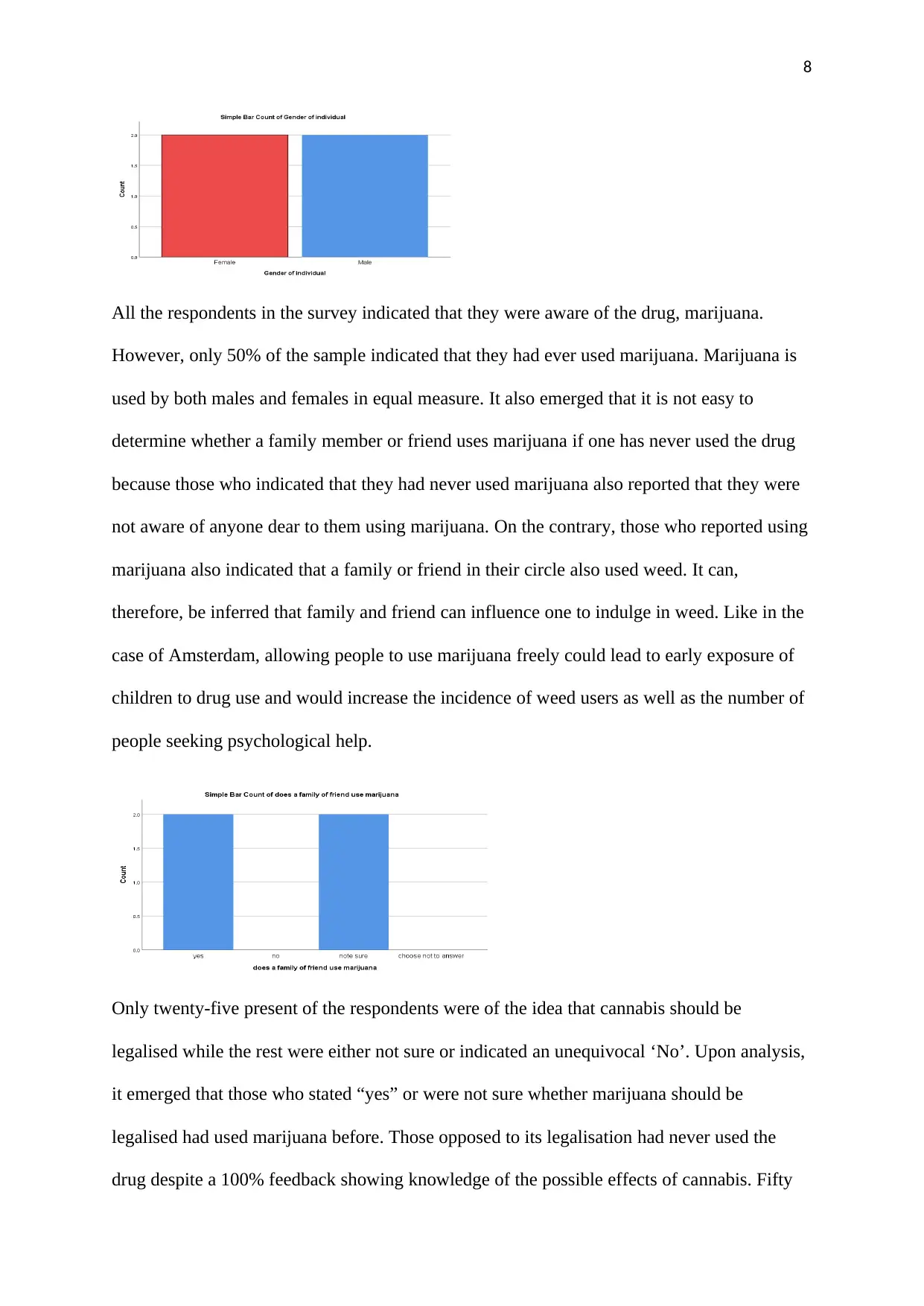
8
All the respondents in the survey indicated that they were aware of the drug, marijuana.
However, only 50% of the sample indicated that they had ever used marijuana. Marijuana is
used by both males and females in equal measure. It also emerged that it is not easy to
determine whether a family member or friend uses marijuana if one has never used the drug
because those who indicated that they had never used marijuana also reported that they were
not aware of anyone dear to them using marijuana. On the contrary, those who reported using
marijuana also indicated that a family or friend in their circle also used weed. It can,
therefore, be inferred that family and friend can influence one to indulge in weed. Like in the
case of Amsterdam, allowing people to use marijuana freely could lead to early exposure of
children to drug use and would increase the incidence of weed users as well as the number of
people seeking psychological help.
Only twenty-five present of the respondents were of the idea that cannabis should be
legalised while the rest were either not sure or indicated an unequivocal ‘No’. Upon analysis,
it emerged that those who stated “yes” or were not sure whether marijuana should be
legalised had used marijuana before. Those opposed to its legalisation had never used the
drug despite a 100% feedback showing knowledge of the possible effects of cannabis. Fifty
All the respondents in the survey indicated that they were aware of the drug, marijuana.
However, only 50% of the sample indicated that they had ever used marijuana. Marijuana is
used by both males and females in equal measure. It also emerged that it is not easy to
determine whether a family member or friend uses marijuana if one has never used the drug
because those who indicated that they had never used marijuana also reported that they were
not aware of anyone dear to them using marijuana. On the contrary, those who reported using
marijuana also indicated that a family or friend in their circle also used weed. It can,
therefore, be inferred that family and friend can influence one to indulge in weed. Like in the
case of Amsterdam, allowing people to use marijuana freely could lead to early exposure of
children to drug use and would increase the incidence of weed users as well as the number of
people seeking psychological help.
Only twenty-five present of the respondents were of the idea that cannabis should be
legalised while the rest were either not sure or indicated an unequivocal ‘No’. Upon analysis,
it emerged that those who stated “yes” or were not sure whether marijuana should be
legalised had used marijuana before. Those opposed to its legalisation had never used the
drug despite a 100% feedback showing knowledge of the possible effects of cannabis. Fifty
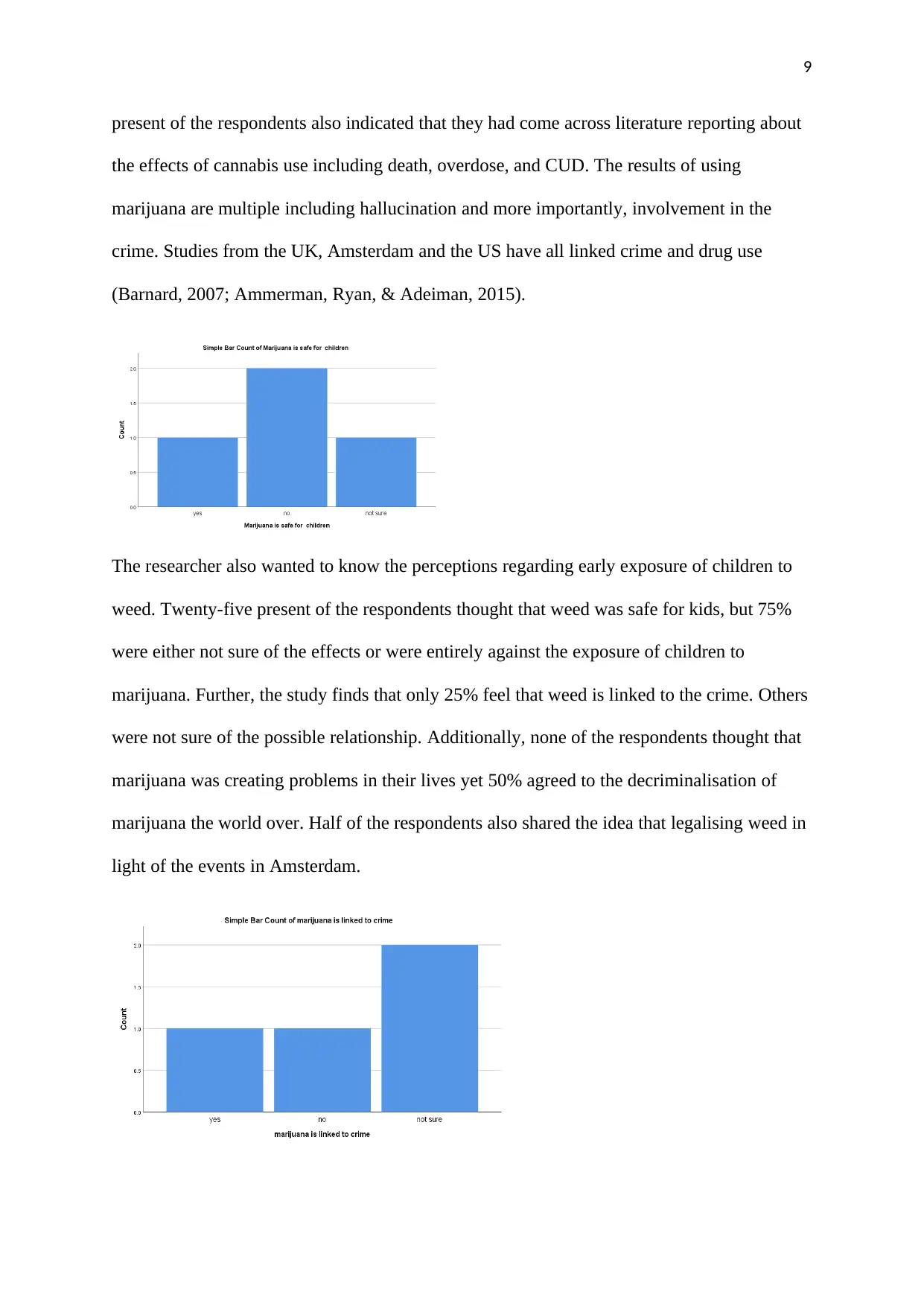
9
present of the respondents also indicated that they had come across literature reporting about
the effects of cannabis use including death, overdose, and CUD. The results of using
marijuana are multiple including hallucination and more importantly, involvement in the
crime. Studies from the UK, Amsterdam and the US have all linked crime and drug use
(Barnard, 2007; Ammerman, Ryan, & Adeiman, 2015).
The researcher also wanted to know the perceptions regarding early exposure of children to
weed. Twenty-five present of the respondents thought that weed was safe for kids, but 75%
were either not sure of the effects or were entirely against the exposure of children to
marijuana. Further, the study finds that only 25% feel that weed is linked to the crime. Others
were not sure of the possible relationship. Additionally, none of the respondents thought that
marijuana was creating problems in their lives yet 50% agreed to the decriminalisation of
marijuana the world over. Half of the respondents also shared the idea that legalising weed in
light of the events in Amsterdam.
present of the respondents also indicated that they had come across literature reporting about
the effects of cannabis use including death, overdose, and CUD. The results of using
marijuana are multiple including hallucination and more importantly, involvement in the
crime. Studies from the UK, Amsterdam and the US have all linked crime and drug use
(Barnard, 2007; Ammerman, Ryan, & Adeiman, 2015).
The researcher also wanted to know the perceptions regarding early exposure of children to
weed. Twenty-five present of the respondents thought that weed was safe for kids, but 75%
were either not sure of the effects or were entirely against the exposure of children to
marijuana. Further, the study finds that only 25% feel that weed is linked to the crime. Others
were not sure of the possible relationship. Additionally, none of the respondents thought that
marijuana was creating problems in their lives yet 50% agreed to the decriminalisation of
marijuana the world over. Half of the respondents also shared the idea that legalising weed in
light of the events in Amsterdam.
⊘ This is a preview!⊘
Do you want full access?
Subscribe today to unlock all pages.

Trusted by 1+ million students worldwide
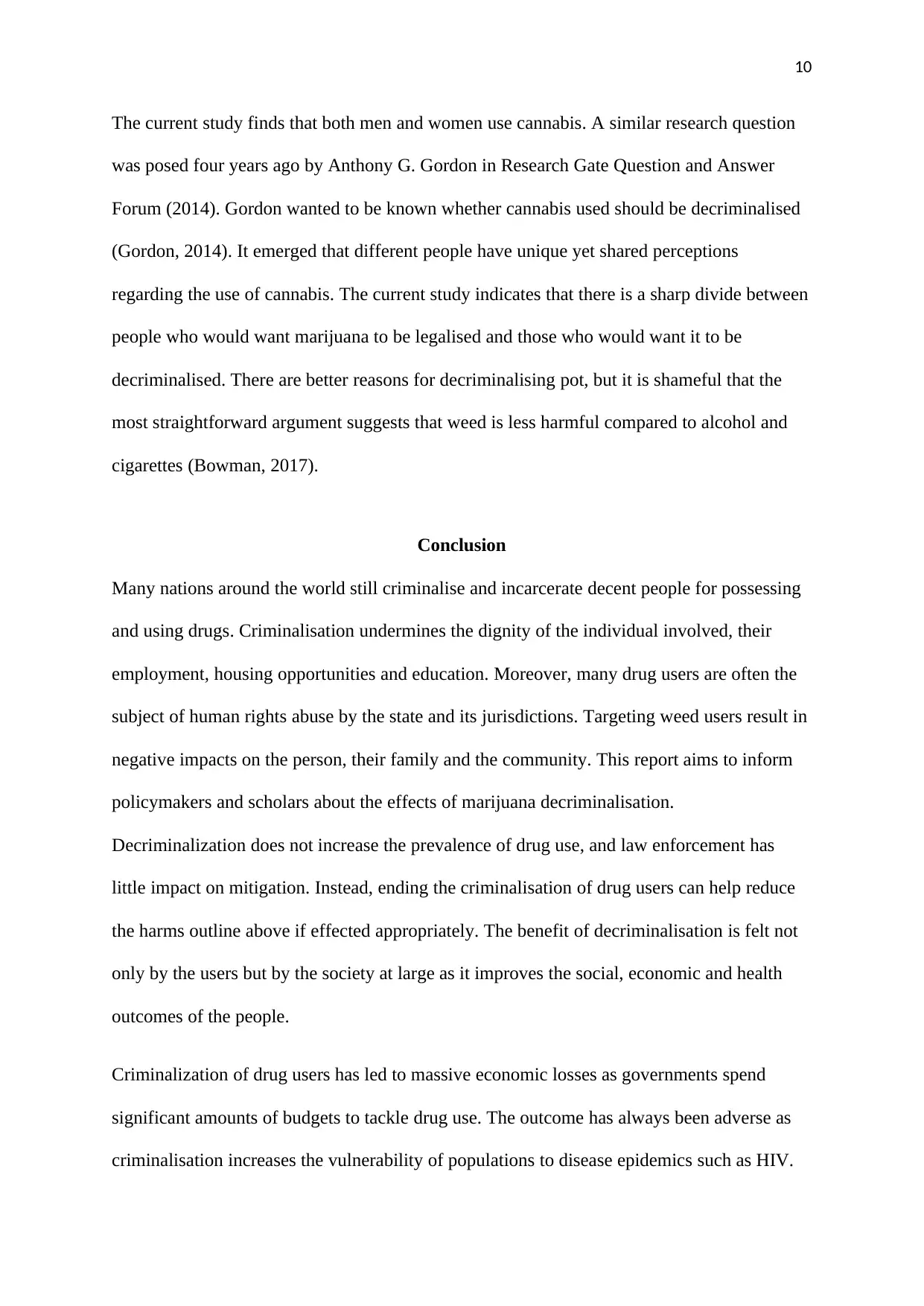
10
The current study finds that both men and women use cannabis. A similar research question
was posed four years ago by Anthony G. Gordon in Research Gate Question and Answer
Forum (2014). Gordon wanted to be known whether cannabis used should be decriminalised
(Gordon, 2014). It emerged that different people have unique yet shared perceptions
regarding the use of cannabis. The current study indicates that there is a sharp divide between
people who would want marijuana to be legalised and those who would want it to be
decriminalised. There are better reasons for decriminalising pot, but it is shameful that the
most straightforward argument suggests that weed is less harmful compared to alcohol and
cigarettes (Bowman, 2017).
Conclusion
Many nations around the world still criminalise and incarcerate decent people for possessing
and using drugs. Criminalisation undermines the dignity of the individual involved, their
employment, housing opportunities and education. Moreover, many drug users are often the
subject of human rights abuse by the state and its jurisdictions. Targeting weed users result in
negative impacts on the person, their family and the community. This report aims to inform
policymakers and scholars about the effects of marijuana decriminalisation.
Decriminalization does not increase the prevalence of drug use, and law enforcement has
little impact on mitigation. Instead, ending the criminalisation of drug users can help reduce
the harms outline above if effected appropriately. The benefit of decriminalisation is felt not
only by the users but by the society at large as it improves the social, economic and health
outcomes of the people.
Criminalization of drug users has led to massive economic losses as governments spend
significant amounts of budgets to tackle drug use. The outcome has always been adverse as
criminalisation increases the vulnerability of populations to disease epidemics such as HIV.
The current study finds that both men and women use cannabis. A similar research question
was posed four years ago by Anthony G. Gordon in Research Gate Question and Answer
Forum (2014). Gordon wanted to be known whether cannabis used should be decriminalised
(Gordon, 2014). It emerged that different people have unique yet shared perceptions
regarding the use of cannabis. The current study indicates that there is a sharp divide between
people who would want marijuana to be legalised and those who would want it to be
decriminalised. There are better reasons for decriminalising pot, but it is shameful that the
most straightforward argument suggests that weed is less harmful compared to alcohol and
cigarettes (Bowman, 2017).
Conclusion
Many nations around the world still criminalise and incarcerate decent people for possessing
and using drugs. Criminalisation undermines the dignity of the individual involved, their
employment, housing opportunities and education. Moreover, many drug users are often the
subject of human rights abuse by the state and its jurisdictions. Targeting weed users result in
negative impacts on the person, their family and the community. This report aims to inform
policymakers and scholars about the effects of marijuana decriminalisation.
Decriminalization does not increase the prevalence of drug use, and law enforcement has
little impact on mitigation. Instead, ending the criminalisation of drug users can help reduce
the harms outline above if effected appropriately. The benefit of decriminalisation is felt not
only by the users but by the society at large as it improves the social, economic and health
outcomes of the people.
Criminalization of drug users has led to massive economic losses as governments spend
significant amounts of budgets to tackle drug use. The outcome has always been adverse as
criminalisation increases the vulnerability of populations to disease epidemics such as HIV.
Paraphrase This Document
Need a fresh take? Get an instant paraphrase of this document with our AI Paraphraser
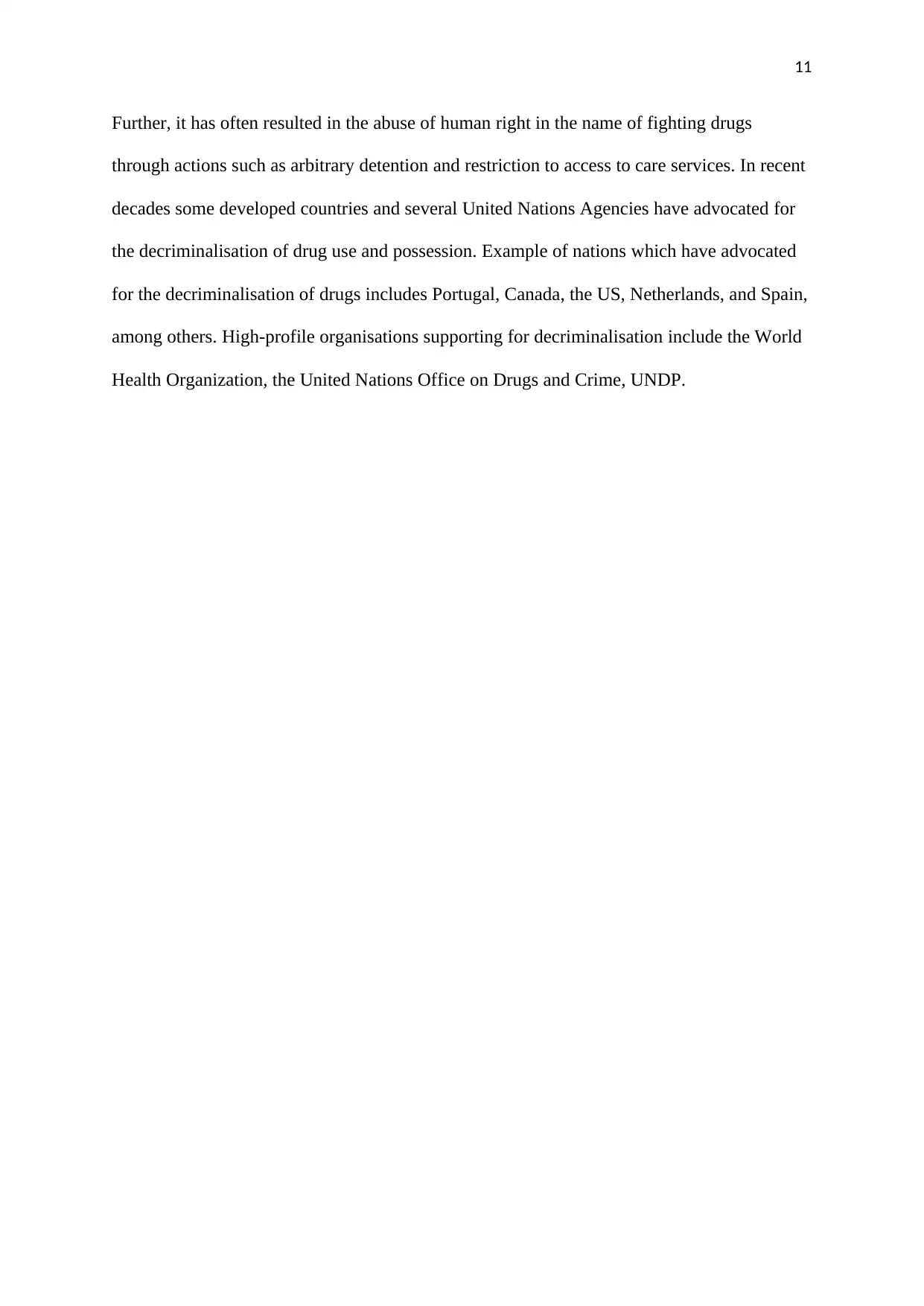
11
Further, it has often resulted in the abuse of human right in the name of fighting drugs
through actions such as arbitrary detention and restriction to access to care services. In recent
decades some developed countries and several United Nations Agencies have advocated for
the decriminalisation of drug use and possession. Example of nations which have advocated
for the decriminalisation of drugs includes Portugal, Canada, the US, Netherlands, and Spain,
among others. High-profile organisations supporting for decriminalisation include the World
Health Organization, the United Nations Office on Drugs and Crime, UNDP.
Further, it has often resulted in the abuse of human right in the name of fighting drugs
through actions such as arbitrary detention and restriction to access to care services. In recent
decades some developed countries and several United Nations Agencies have advocated for
the decriminalisation of drug use and possession. Example of nations which have advocated
for the decriminalisation of drugs includes Portugal, Canada, the US, Netherlands, and Spain,
among others. High-profile organisations supporting for decriminalisation include the World
Health Organization, the United Nations Office on Drugs and Crime, UNDP.
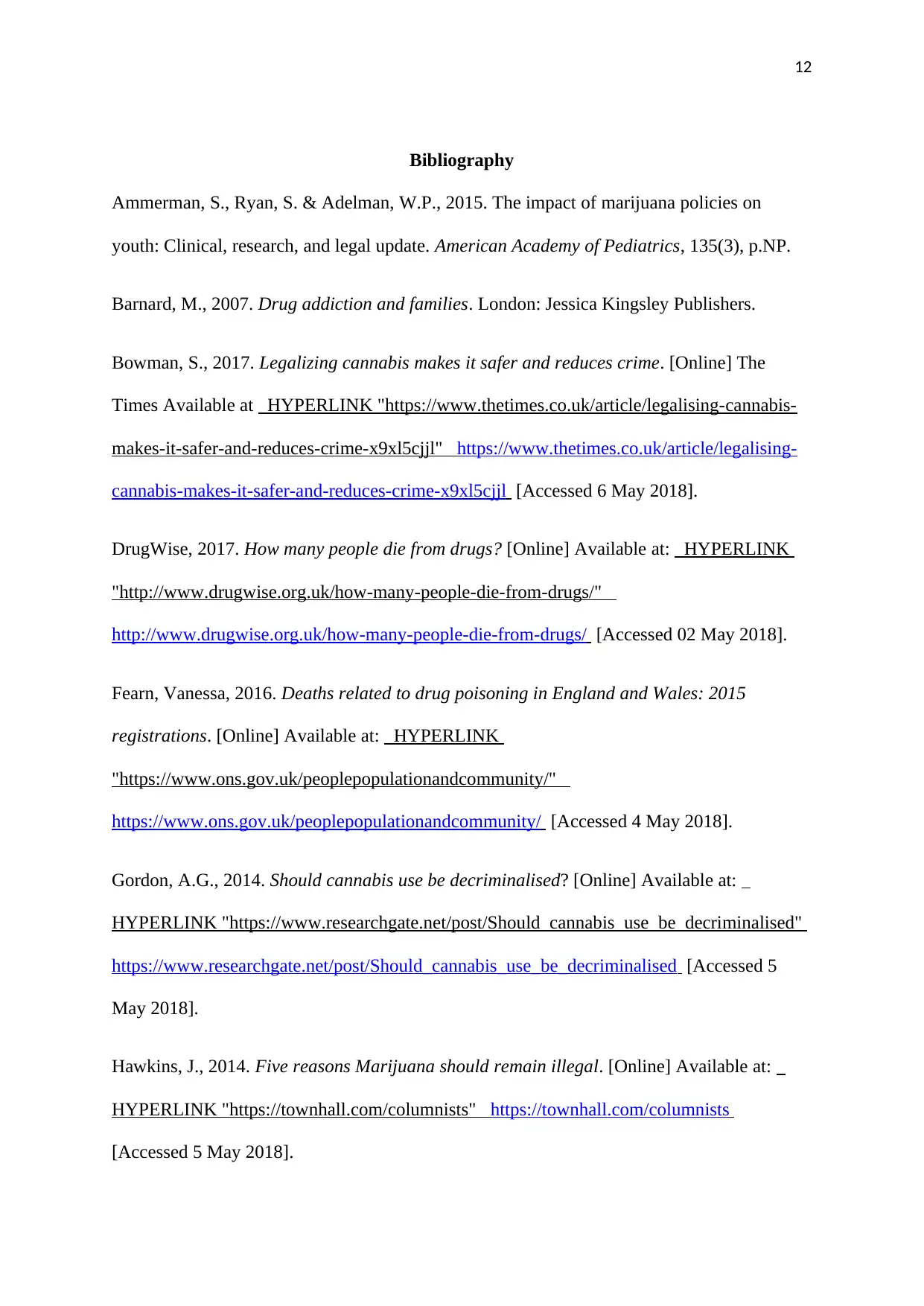
12
Bibliography
Ammerman, S., Ryan, S. & Adelman, W.P., 2015. The impact of marijuana policies on
youth: Clinical, research, and legal update. American Academy of Pediatrics, 135(3), p.NP.
Barnard, M., 2007. Drug addiction and families. London: Jessica Kingsley Publishers.
Bowman, S., 2017. Legalizing cannabis makes it safer and reduces crime. [Online] The
Times Available at HYPERLINK "https://www.thetimes.co.uk/article/legalising-cannabis-
makes-it-safer-and-reduces-crime-x9xl5cjjl" https://www.thetimes.co.uk/article/legalising-
cannabis-makes-it-safer-and-reduces-crime-x9xl5cjjl [Accessed 6 May 2018].
DrugWise, 2017. How many people die from drugs? [Online] Available at: HYPERLINK
"http://www.drugwise.org.uk/how-many-people-die-from-drugs/"
http://www.drugwise.org.uk/how-many-people-die-from-drugs/ [Accessed 02 May 2018].
Fearn, Vanessa, 2016. Deaths related to drug poisoning in England and Wales: 2015
registrations. [Online] Available at: HYPERLINK
"https://www.ons.gov.uk/peoplepopulationandcommunity/"
https://www.ons.gov.uk/peoplepopulationandcommunity/ [Accessed 4 May 2018].
Gordon, A.G., 2014. Should cannabis use be decriminalised? [Online] Available at:
HYPERLINK "https://www.researchgate.net/post/Should_cannabis_use_be_decriminalised"
https://www.researchgate.net/post/Should_cannabis_use_be_decriminalised [Accessed 5
May 2018].
Hawkins, J., 2014. Five reasons Marijuana should remain illegal. [Online] Available at:
HYPERLINK "https://townhall.com/columnists" https://townhall.com/columnists
[Accessed 5 May 2018].
Bibliography
Ammerman, S., Ryan, S. & Adelman, W.P., 2015. The impact of marijuana policies on
youth: Clinical, research, and legal update. American Academy of Pediatrics, 135(3), p.NP.
Barnard, M., 2007. Drug addiction and families. London: Jessica Kingsley Publishers.
Bowman, S., 2017. Legalizing cannabis makes it safer and reduces crime. [Online] The
Times Available at HYPERLINK "https://www.thetimes.co.uk/article/legalising-cannabis-
makes-it-safer-and-reduces-crime-x9xl5cjjl" https://www.thetimes.co.uk/article/legalising-
cannabis-makes-it-safer-and-reduces-crime-x9xl5cjjl [Accessed 6 May 2018].
DrugWise, 2017. How many people die from drugs? [Online] Available at: HYPERLINK
"http://www.drugwise.org.uk/how-many-people-die-from-drugs/"
http://www.drugwise.org.uk/how-many-people-die-from-drugs/ [Accessed 02 May 2018].
Fearn, Vanessa, 2016. Deaths related to drug poisoning in England and Wales: 2015
registrations. [Online] Available at: HYPERLINK
"https://www.ons.gov.uk/peoplepopulationandcommunity/"
https://www.ons.gov.uk/peoplepopulationandcommunity/ [Accessed 4 May 2018].
Gordon, A.G., 2014. Should cannabis use be decriminalised? [Online] Available at:
HYPERLINK "https://www.researchgate.net/post/Should_cannabis_use_be_decriminalised"
https://www.researchgate.net/post/Should_cannabis_use_be_decriminalised [Accessed 5
May 2018].
Hawkins, J., 2014. Five reasons Marijuana should remain illegal. [Online] Available at:
HYPERLINK "https://townhall.com/columnists" https://townhall.com/columnists
[Accessed 5 May 2018].
⊘ This is a preview!⊘
Do you want full access?
Subscribe today to unlock all pages.

Trusted by 1+ million students worldwide
1 out of 15
Your All-in-One AI-Powered Toolkit for Academic Success.
+13062052269
info@desklib.com
Available 24*7 on WhatsApp / Email
![[object Object]](/_next/static/media/star-bottom.7253800d.svg)
Unlock your academic potential
Copyright © 2020–2025 A2Z Services. All Rights Reserved. Developed and managed by ZUCOL.

